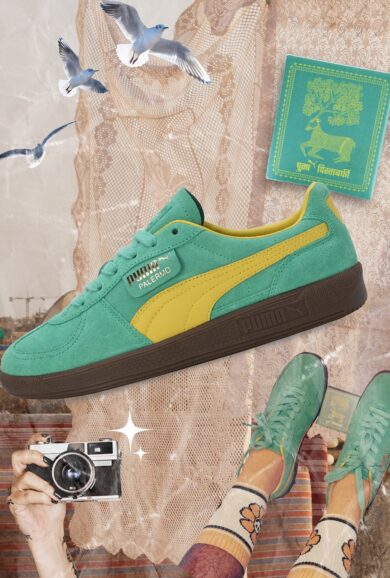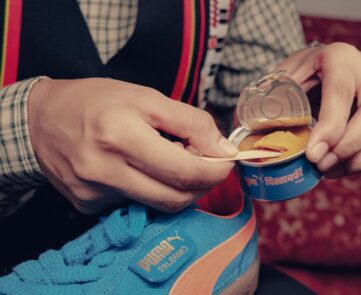Harshit Agrawal speaks to Blur The Border:
BTB: How did the collaboration with G-SHOCK come about? Can you share a pivotal moment or connection that helped bring this partnership to life?
Harshit: Honestly, it came about quite organically. We were working on a new drop for Pistabarfi, something fun, a little irreverent, rooted in nostalgia but designed in a more playful, accessible way. Around the same time, Puma was gearing up for new Palermo drops and were looking to collaborate with homegrown brands that aligned with their ethos.
They reached out to us because they’d been following what we were doing, how we were reimagining traditional mithai without being stuck in convention without changing the original essence of the very product. And I think that’s what really clicked. Both brands shared a similar spirit: taking something classic and giving it a fresh, cool spin.
At our end, we were already working on two products, our Aam Papad strips and the Mysore Pak in a can. Puma loved the idea, and we ended up redesigning the packaging in their Palermo colors. That became an exclusive Puma x Pista Barfi drop, the first time
We launched those products, and it happened as part of that collaboration. So yeah, it was a great meeting of minds and design, and a really fun launch.
BTB: From initial discussions to final execution, what was the overall timeline to create the pieces? What were the key stages or turning points in the process?
Harshit: The whole process took about two and a half months from start to finish. In terms of key stages, the first was definitely the initial conversations. Just chatting with the Puma team, understanding what they had in mind, the vibe they were going for, and exchanging early ideas.
The second stage kicked in once we had a rough idea of the products. That’s when the packaging discussions began, figuring out how to bring the Palermo colors into our design language. A big part of that stage was also how the Puma x Pista Barfi logo would appear. Right now, "Puma" is written in Devanagari, and that went through quite a few iterations before we locked the final look. The third stage was refining the product and packaging itself. We eliminated a few product options and zeroed in on the Aam Papad and Mysore Pak. From there, it was all about finessing the details, from the GSM of the paper to the aluminum foil wrap, how it folds, the feel of the pack, and how smoothly it opens. There were quite a few design and material choices we worked through to get it right.
And finally, once all of that was locked, it was time to shoot. That was a major piece too, figuring out how to visually bring together the ethos of Puma and Pista Barfi in a single frame, blending both aesthetics into something cohesive and fun. Those were pretty much the key steps that brought the collab to life.

BTB: What were the biggest creative or technical challenges in adapting your design language to an entirely new category or product line?
Harshit: What we’re trying to do with Pistabarfi is make traditional mithai more accessible through better design and packaging. That hasn’t been a challenge only during the Puma collaboration. These were products we had already been developing before Puma got in touch. The timing just worked out. We were about to launch them independently, and the partnership gave them a much bigger platform.
This also wasn’t the first time we worked on something in that space. Earlier, we had launched a mithai bar, which was kaju katli in the shape of a chocolate bar. It was meant to be portable and easy to eat on the go. One of the biggest issues I’ve seen, especially coming from a halwai family, is that mithai is not designed for personal consumption. It usually comes in large boxes, is sticky, and hard to carry. That makes it messy and inconvenient to eat casually.
That’s the main problem we’re trying to solve. Since no one has really done it, there’s no playbook. Everything has been trial and error. We’ve had to learn about materials, shelf life, packaging, and what works for perishable products. And because we’re bootstrapped, it’s just me and my brother doing everything ourselves. That makes things slower and more hands-on, but also more meaningful.
So to answer the question, the Puma collab didn’t involve creating a new category. The products already existed. The only thing we really adapted was the packaging, to match the Palermo sneaker colors. That meant tweaking materials, finishes, and getting the visual tone right.
The bigger creative and technical challenges are ongoing. We’re building a new way for people to experience mithai. The Puma collab was just one example of how that idea can live in different contexts.
BTB: Were there any learning or new perspectives that you gained from working with a globally recognised brand, especially around logistics, communication, or scaling up production?
Harshit: It was honestly like serving any of our other clients. We often work with people who come to us with specific customization requests, and we enjoy that process. The main difference when working with a brand, as opposed to an individual, is the structure. With a brand, there is a hierarchy, multiple levels of approval, and a more formal decision-making process. With an individual, it's usually a single point of contact and things tend to move faster.
But we’re quite used to that kind of setup. We’ve worked with corporates before, so the flow felt familiar. At the end of the day, the fundamentals are the same — clear communication, meeting timelines, and delivering a high-quality product. It’s about doing the basics well and staying consistent.
BTB: What guidance or insights would you share with emerging brands looking to engage in meaningful global collaborations?
Harshit: I don’t know if I have advice for others, to be honest. I can only share what’s worked for us. And if that resonates with someone, great. But I really don’t think there’s a one-size-fits-all formula.
For us, it’s always been about doing what we genuinely believe in and having fun with it. That way, it never feels like we’re trying to impress anyone or follow a trend. We just play with ideas, try to create something fresh, and push the boundaries a little while staying true to our core.
Over the years, I think that consistency and honesty in our work is what’s made people notice. We’ve never had a PR or advertising agency promoting us. Even in the case of Puma, they reached out to us directly.
So if there’s one thing I can share, it’s this. Be clear about what you’re doing and why you're doing it. Even if you’re still figuring it out, enjoy the process. When your work reflects something honest or original, the right people will find their way to you. That’s when collaborations feel real and exciting, not just something you’re chasing for the name. That’s what has worked for us so far.


